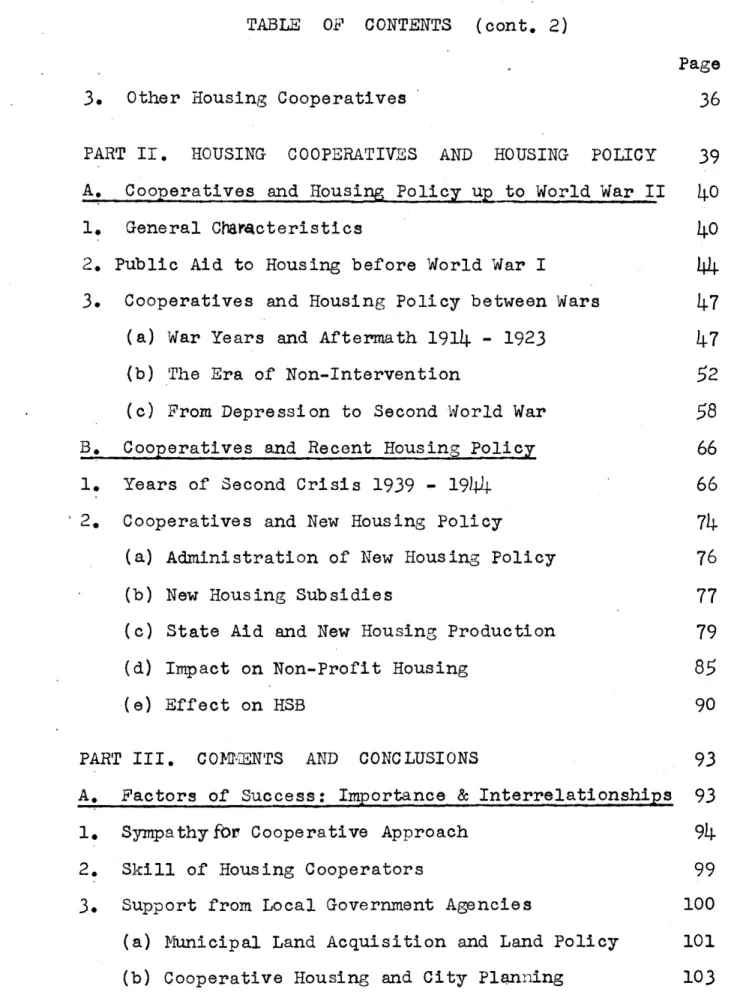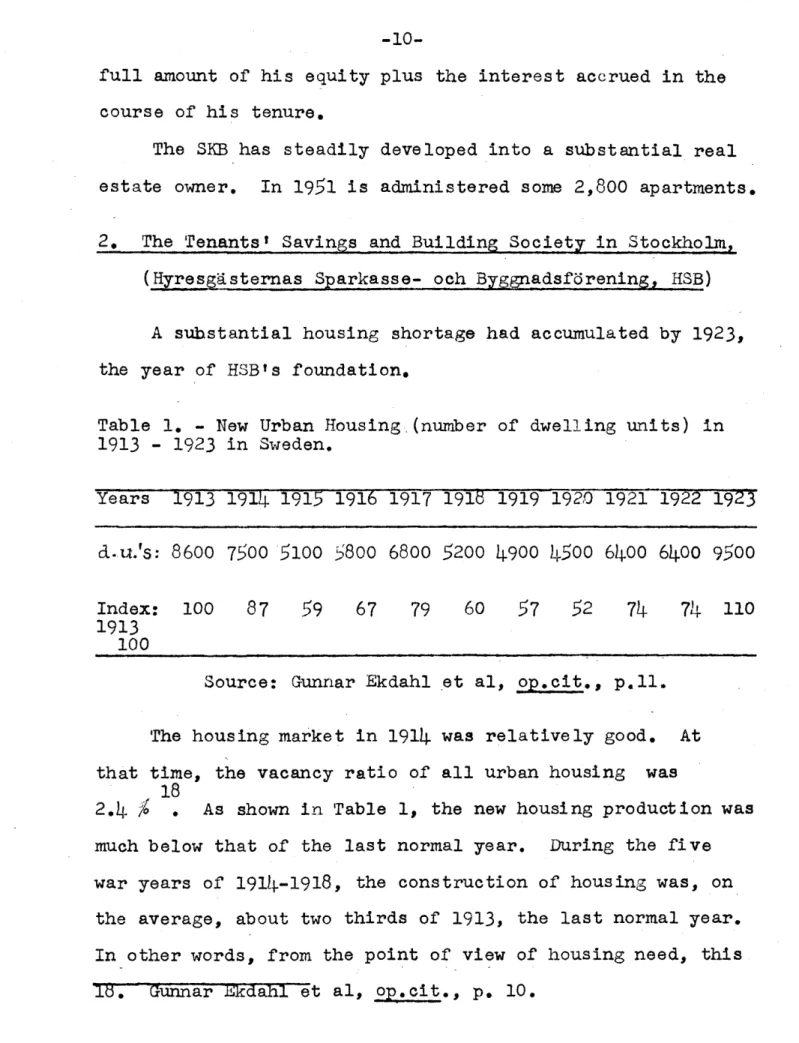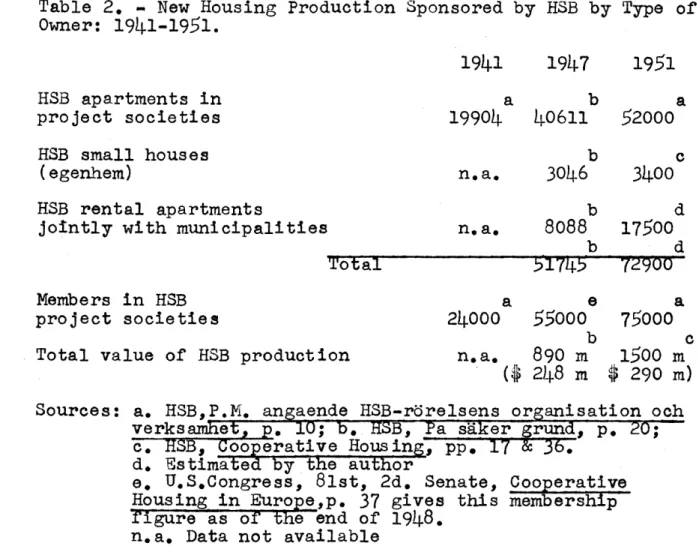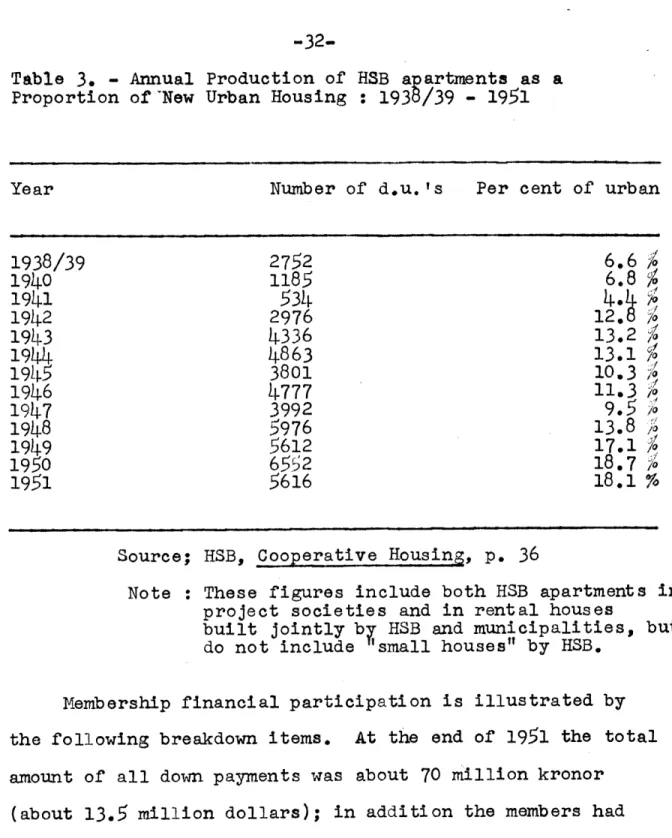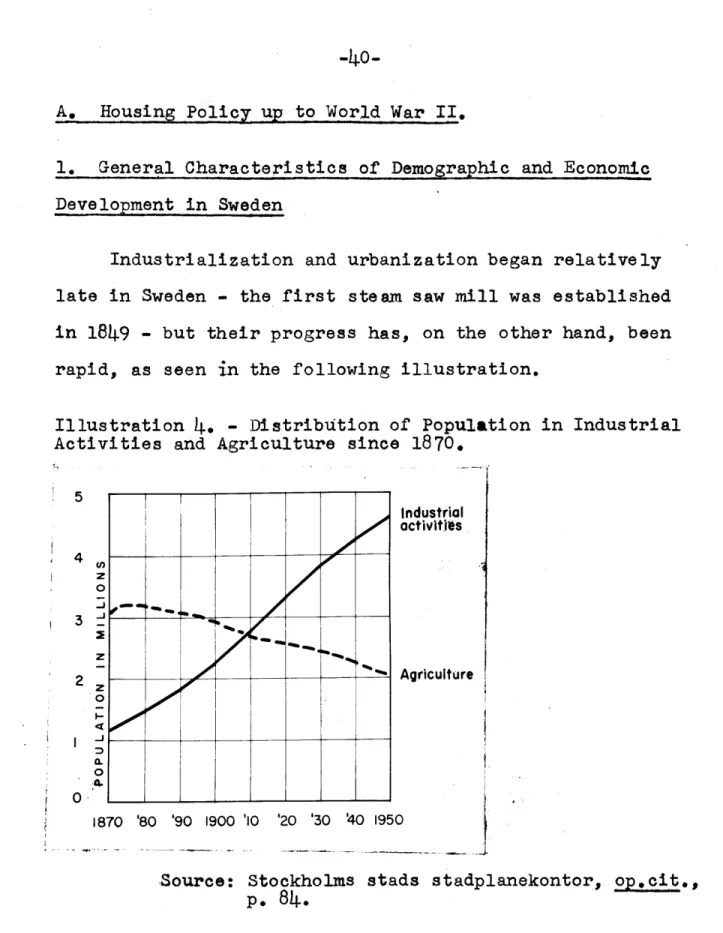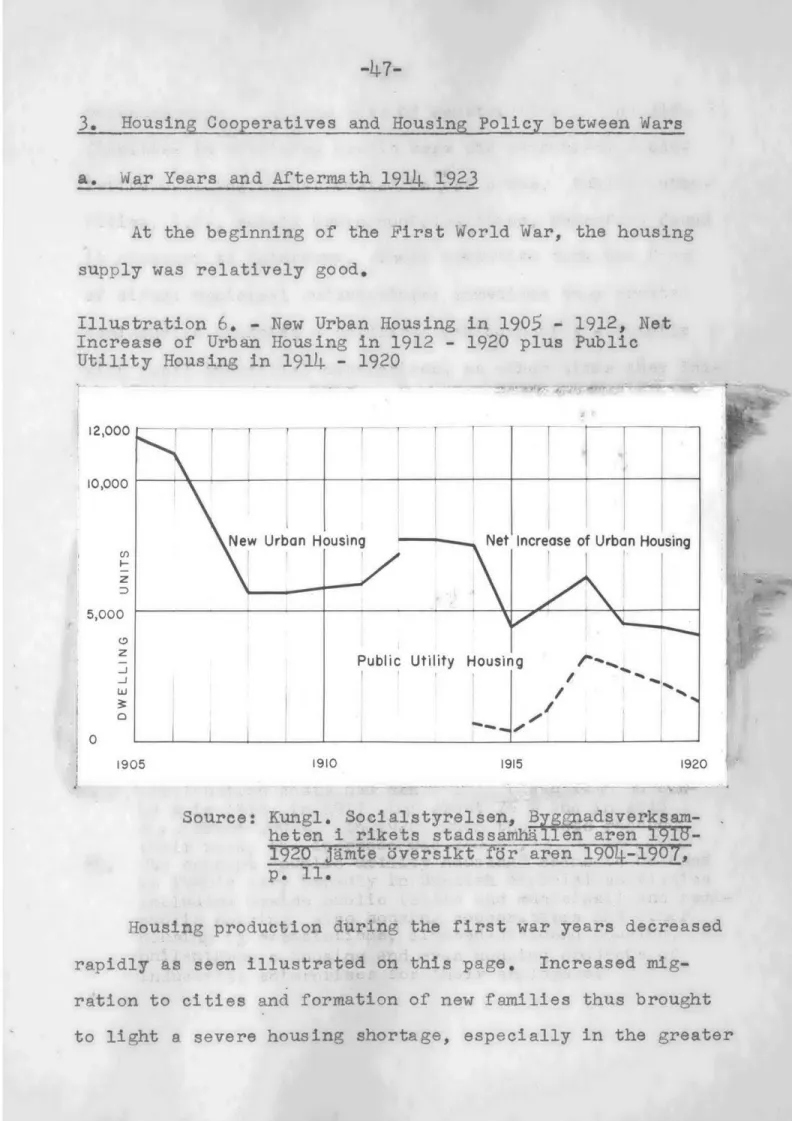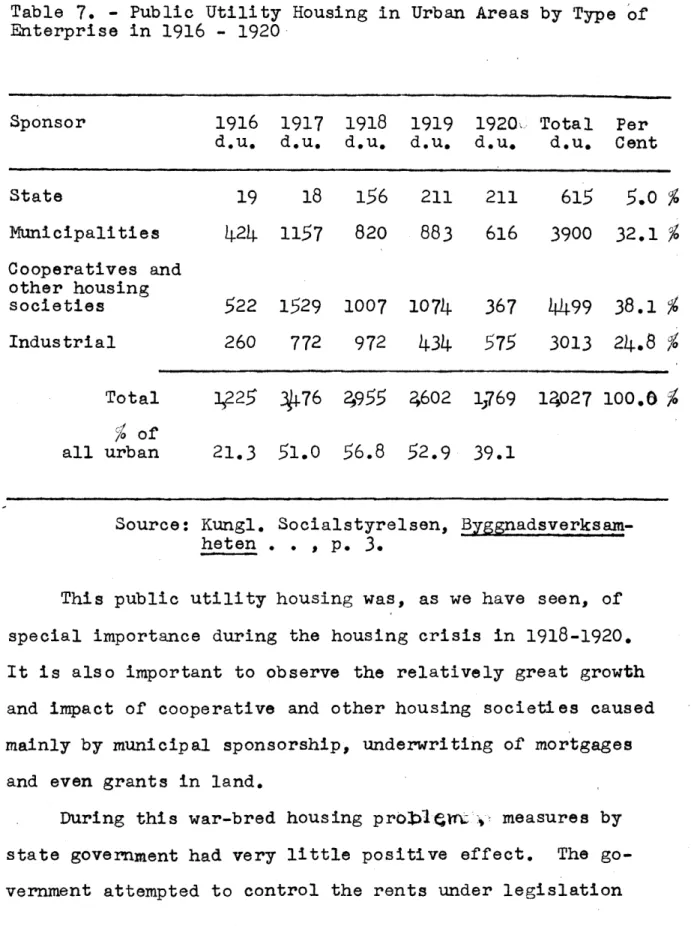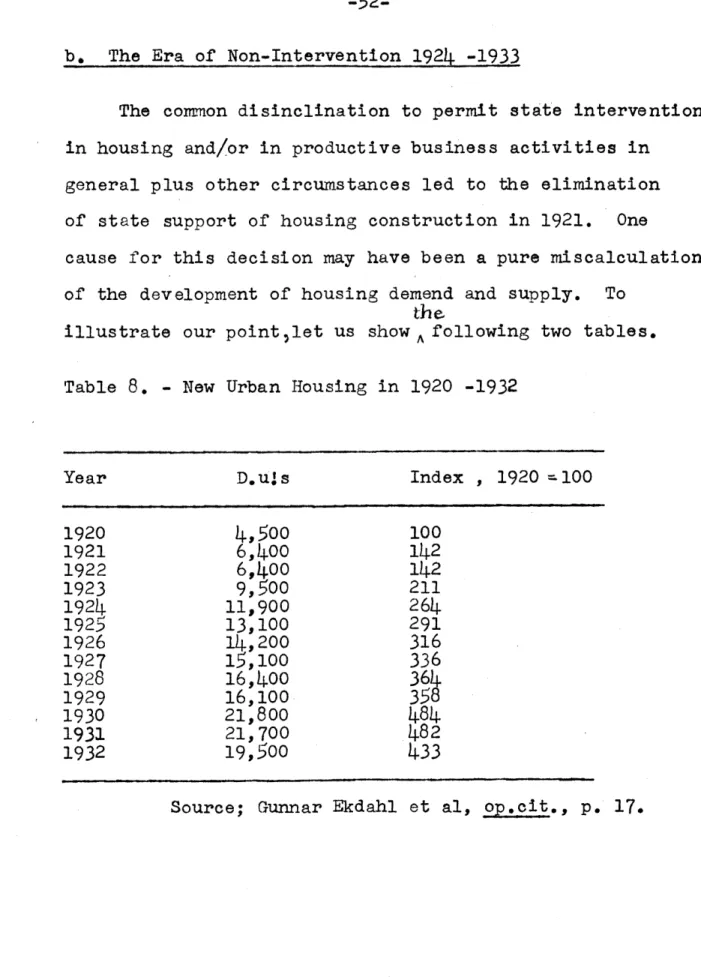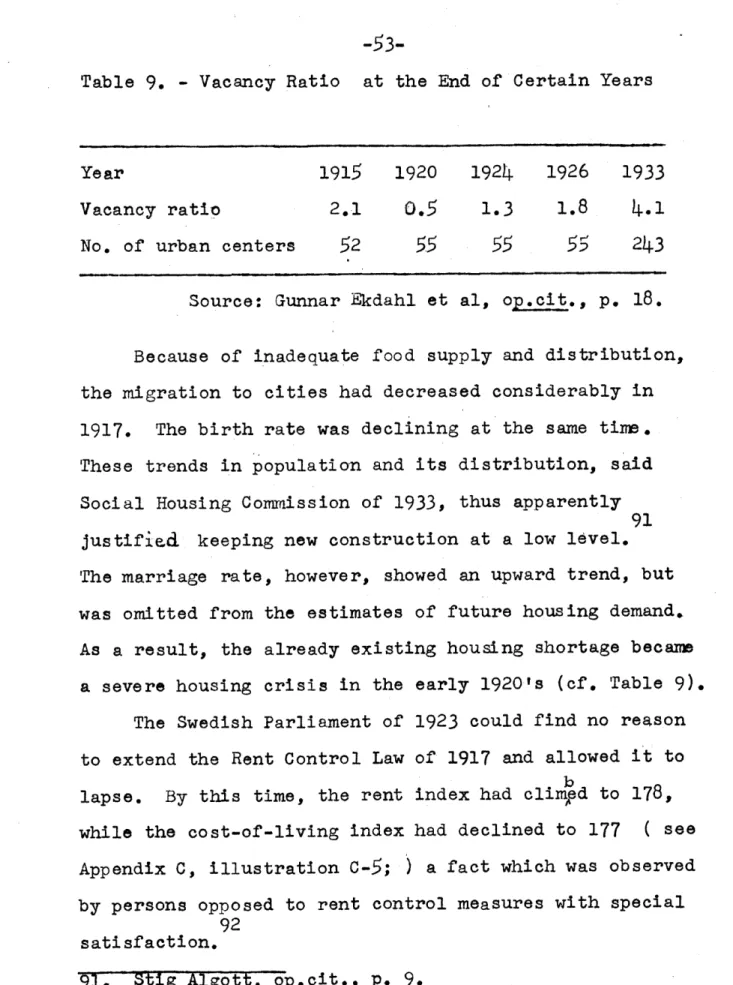Tuure Torsten Kulmala
L1.B., University of Helsinki, Finland 1940
Dipl. Eng., Finland's Institute of Technology, Helsinki,
1942
Submitted in Partial Fulfilment of the Requirements for the Degree of Master in City Planning at the
Massachusetts Institute of Technology.
Head of the Department of City and Regional Planning
Author's signature
'A
Frederick J. '*dams
Torsti Kulmala
Massachusetts Institute of Technology Cambridge, Massachusetts
April 21,
1954
COOPERATIVE APARTMENTS IN SWEDEN
A Study of The Tenants' Cooperative Housing Movement with
Special Reference to General Housing Policy in Sweden.
Torsti Kulmala April 21, 1954
Professor Frederick J. Adams, Head Departnent of City and Regional Planning Massachusetts Institute of Technology Cambridge, Massachusetts
Dear Professor Adams:
I respectfully submit herewith a thesis entitled Cooperative Apartments in Sweden, A Study of The Tenants' Cooperative Housing Movement with Special Reference to General Housing Policy in Sweden in partial fulfilment of the requirements for the degree of Master in City Planning.
Abstract: COOPERATIVE APARTMENTS IN SWEDEN
A Study of The Tenants' Cooperative Housing Movement with Special Reference to General Housing Policy in Sweden. by Tuure Torsten Kulmala
submitted to the Department of City and Regional Planning on April 21,
1954
in partial fulfilment of the require-ments for the degree of Master in City Planning.This study is based largely on official Swedish sources and material from HSB, The Tenants' Savings and Building
Society-Movement and is focused on a typical example -the HSB apartments.
The purpose of the study is to show the four basic reasons ror the success or the cooperative housing movement in Sweden:
1. Sympathy for the cooperative approach
2. Organizational strength and administrative skill
3. Support from local government agencies
4.
Support and financial aid from the State government Their functional and historical interrelationships and rela-tive importance are discussed in the light of the support and collaboration of labor's existing economic and political expressions: the related consumers' cooperative and trade union movements and the Social Democratic Party. The role of housing cooperatives in public housing and financing is shown against the perspective of urbanization, modern city planning concepts and municipal land policy.In conclusion it can be said that large-scale operations in the construction of both projects and materials, plus the continuity in research and experience afforded by HSB have a more profound effect on the modern-day housing market than the cooperative approach as such, whicfi, however, helps
mobilize the necessary capital and support. Although it has not yet been possible to serve the lowest income groups, the
author believes that the cooperative approach reduces the costs both for the tenant and the society as a whole.
Thesis Supervisor:_ _____ Llo-ycy odwin Associate Professor of Land Economics
Page INTRODUCTION
A. Purpose of the Study
B. Its Organization iv
C. Sources viii
PART I. HOUSING COOPERATIVES 1
A. Pre-Cooperative or Groping St age 2
1. Early Housing Cooperatives 2
2. Their Scope and Success 14.
B. Organizational Stage 6
1. The Cooperative Housing Society of Stockholm 7 2. The Tenantst Savings and Building Society 10
C. Centralized Stage
14
1. Aims of the HSB-Movement 114.
2. Organizational Characteristics of the HSB 16 3. Legal and Administrative Aspects of the HSB 19
(a) Legal Aspects 19
(b) Administrative Aspects 22
1.. Financial Aspects of the HSB 25
(a) Project vs. Local Societies 25
(b) Member-owner vs. Project and Local Societies 28
56
Facts Regarding HSB-Achievements. 31D. Specialized Stage 33
1. HSB and Self-Help Housing 33
TABLE OF CONTENTS (cont. 2)
Page
3. Other Housing Cooperatives 36
PART II. HOUSING COOPERATIVES AND HOUSING POLICY 39 A. Cooperatives and Housing Policy up to World War II
40
1. General Characteristics
40
2. Public Aid to Housing before World War I
14
3. Cooperatives and Housing Policy between Wars
47
(a) War Years and Aftermath 1914 - 192347
(b) The Era of Non-Intervention
52
(c) From Depression to Second World War
58
B. Cooperatives and Recent Housing Policy 66 1. Years of Second Crisis 1939 - 1944 66 2. Cooperatives and New Housing Policy 74 (a) Administration of New Housing Policy 76(b) New Housing Subsidies 77
(c) State Aid and New Housing Production 79
(d) Impact on Non-Profit Housing 85
(e) Effect on HSB 90
PART III. COMM.ENTS AND CONCLUSIONS 93
A. Factors of Success: Importance & Interrelationships 93
1. Sympathyfor Cooperative Approach
94
2. Skill of Housing Cooperators 99
3.
Support from Local Government Agencies 100 (a) Municipal Land Acquisition and Land Policy 101 (b) Cooperative Housing and City Planning 1034..
Support and Aid from the State Government B. Comments and-Implications1. Cooperative Approach
2. HSB and Low-Income Housing
3. Cooperative Housing vs. Public Utility Housing
Appendix A
Origin of Consumers' Cooperative Movement in Sweden
Appendix B
Organizational Set-Up of the HSB-Movement
Appendix C
Tables and Illustrations
Bibliography Page 107
108
109 112 114 117 124 131 139LIST OF TABLES AND ILLUSTRATIONS
Page Table 1. - New Urban Housing (number of dwelling
units) in 1913 - 1923 10
Table 2. - New Housing Production Sponsored by HSB
by Type of Owner: 1941 - 1951 31
Table 3. - Annual Production of HSB-apartments as a
Proportion of New Urban Housing: 1938/39 - 1951 32 Illustration 4. - Distribution of Population in
Industrial Activities and Agriculture Since 1870 40 Table
5.
- Number and Size of Urban Centers in 194543
Illustration 6. - New Urban Housing in 1905 - 1912and Net Increase of Urban Housing in 1912 - 1920
plus Public Utility Housing in 1914 - 1920
47
Table 7. - Public Utility Housing in Urban Areasby Type of Enterprise in 1916 - 1920
50
Table 8. - New Urban Housing in 1920 - 193252
Table 9. - Vacancy Ratio at the End of Certain
Years
53
Table 10. - Annual Production of HSB-ap artments as a Proportion of New Urban Housing in 1924 - 1935
56
Table 11. - New Non-Farm Housing in 1933 - 1939
59
Table 12. - New Urban Housing by Type of Enterprise
in 1925/34 and from 1933 to 1939 63
Illustration 13. - New Urban Housing and New Urban Housing Financed by State Loans and Subsidies in
1939 -
1945
67Illustration 14. - New Housing Production in
1937 - 1952 80
Table 15. - State Aid for New Housing, Urban and
Rural, from 1949 tO 1952, per cent of total 81 Table 16. - New Urban Housing by Size of Apartments
Page Table 17. - All New Housing by Type of Sponsor/
Builder from 1949 to 1952, number of dwelling units
and per cent of total 86
Table 18. - Multi-family Housing by Type of Sponsor/Builder in Planned Housing Projects in
Certain Years, per cent of total 87
Table 19. - Various State Loans and Subsidies, Other Public Benefits and Restrictions by Type
of Sponsor/Builder in 1948
88
Table 20. - Financing of an Apartment Building
by Type of Sponsor/Builder in 19)48 88
APPENDIX TABLES AND ILLUSTRATIONS
Illustration B-1. - The Organizatiqn of the HSB
Housing Movement 129'
Illustration B-2. - Administrative Relationships between Project, and Local HSB-socie ties and The
National HSB 130
Illustration C-1. - New Urban Housing from 1934 to 1946 and All New Housing from 1949 to 1952
by Type of Owner 131
Table C-2. - New Housing Production (dwelling units)
ffrom 1938 to 1952 132
Table C-3. - All New Housing by Type of Housing
from 1949 to 1952, number of dwelling units and
per cent of total 133
Table C-4. - All New Housing in 1951 (number of dwelling units) Distributed Among Various Building Types and Local Governmental Units in Relation to
State Financial Aid 134
Illustration C-5. - Indices of Induistrial Wage.s,
Cost-of'-Liviig and Rent from 1913 to 1945 135 Table C-6. - Indices of Rent and Cost-of-Living
LIST OF TABLES AND ILLUSTRATIONS (cont. 3) Page Illustration 0-7. - Diagram Showing through what
Organizations the Three Largest Social Groups -Workers, Professional and Commercial Employees and Farmers - Protect their Earning and
Income-Spending Interests 137
Table C-8. - Foreign Exchange Rates, United States
A Study of The Tenants' Cooperative Housing Movement with
Special Reference to General Housing Policy in Sweden
Introduction and Summary
A. Purpose of the Study.
The contribution, both material and social, of the cooperative housing movement in Sweden has been of clear and considerable importance. It has provided tens of thousands of working class families with decent homes at a cost demonstrating the value of continuous, large-scale building enterprise. It has shown the value of long-range planning in the housing field and raised general interest in housing, particularly in its social-reform aspects.
The purpose of this study is to show what we believe to be the four basic reasons for the success of the coope-rative housing movement in Sweden, andby implication, some of the factors necessary to the success of such a movement elsewhere:
Point 1. Sympathy for the Cooperative Approach.
Consumer cooperatives and housing cooperatives got an early start in part because of traditional beliefs in mutual self-help,-not forgotten during rapid urbanization
-of Housing Cooperators.
Experience gained through early cooperative housing attempts since 1870 helped to develop a group.of devoted leaders, who, with the support .of the people in need of housing, succeeded in establishing a strong central orga-nization for the'cooperative housing movement. Thus the
"know-how" for the large-scale activities, both in
construction and management of housing projects, was
kept within the organization and the continuity of opera-tions was ensured by a strong organizational structure.
Point
3.
Support from Local Government Agencie_.Participation of local governments first occurred during the severe housing crisis of the First World War, when private building had actually stopped in many urban
areas. Their help took the form of initiating housing societies and supporting them with land and loans. This help, however, was not restricted to cooperative housing societies only, but also given to other housing under-takings of non-speculative character. The close relation-ship between municipal auhtorities and cooperative housing
-ii-and in part because of an. adult education program that spread the cooperative housing idea in labor societies and labor unions early and far.
societies in the beginning of the modern cooperative housing movement in Sweden, one generation ago, has been maintained on a friendly level. It has led to the estab, lishment of semi-municipal housing agencies with coope-rative participation; initially for the promotion of housing for certain social groups - low-income families with many children, and the aged - and later, for the promotion of rental housing in general.
Point
4.
_Spport and Financial Aid from the State Government,Consumer cooperatives and housing cooperatives have been able to operate within an appropriate legal frame-work from the end of 19th Century on. State financial
support for housing cooperatives is of relatively recent origin, dating from the critical years of the Second World War. It arose out of the desire of state authori-ties to eliminate the speculative aspects in the financing, building and administration of housing.
To evaluate the relative importance of these four factors or contributing forces is difficult. Cooperative housing in Sweden was a product of crisis, a real
"war-child". In its modern form, it was born with local help in an emergency situation following the First W§rld War and then received a further push to maturity by state support during the second housing crisis of 1939 - 194.
-iv-The cooperative housing movement did not grow in a social vacuum. In Sweden, there were many factors promoting its success - the whole political setting, in fact, was
favorable. Relatively great homogeneity in race and religion, acceptance of state paternalism in many fields of social and economic activity and high standard of living due in large part to Sweden's neutrality during the two World Wars, made it economically and politically fe-asible
to carry out the substantigl, socially oriented housing program in which cooperative housing was to have so a
large share.
B. Organizationffthe Study.
This report will deal mainly with cooperative apartments, i.e. cooperative housing societies providing their members with permanent leases. Single-ffamily cooperatives are omitted because of lack of information, lesser importance and atypical characteristics of full ownership, public grants and supervision. One further limitation is that our discussion is focused on one organization, namely The Tenants' Savings and Building Society-Movement
(Hyresgdsternas Sparkasse- och Byggnadsfdrening, HSB ); this is because HSB is the oldest and biggest nationwide organization.
we will analyse the development of the cooperative housing movement from the early scattered housing societies into an organized, nationwide HSB-movement, from which history Points 1 and 2 are derived.
It will be shown how closely early housing societies were related to the labor movement and consumers' coopera-tive movement ( detesils in Appendix A
),
and how theparticipation of the tenants themselves and of their unions led first to the establishment of The Cooperative Housing Society of Stockholm under municipal supervision in 1916, then to the creation of the HSB-society in Stockholm in 1923 and to the establishment of the National HSB a year later. Then follows a discussion of the aims of the.HSB-movement and of its organizational characteristics and
legal and administrative aspects. It will be shown how HSB, with its peculiar organizational set-up, has been able to create a strong central organization for coope-rative housing, thus reaping the benefits of continuous large-scale housing production andk. of accumulated
experience. -(More detailed information regarding the complicated structure of the HSB is given in Appendix B.) Financial relationships between project and local societies, and between member-owners and project or local societies are explained. A review of the material achievements of the HSB-movement follows. Some special aspects of the
-vi-activities of the HSB, not strictly cooperative, are also studied - namely promotion of self-help housing and pro-duction of building materials. Finally a brief discussion of other housing cooperatives endsPart I.
In Part II, attention is focused on Points 3 and 14. Here we will analyse the development of housing coope-ratives since World War I in relation to general housing policy in Sweden up to the present. It will be shown how municipal initiative and support gave a great push to the cooperative housing movement during the housing cisis
following the First War. The development of the
HSB-movement from a strictly cooperative agency - selling its apartments to its members - into a service agency for
municipalities and other authorities is discussed together with major governmental housing policy decisions in the
late 1930's. The second housing crisis of 1939 - 1944
is then analysed and governmental aid reviewed in their relation to housing cooperatives. It will be shown how the increasingly favorable attitude of state authorities
towards non-speculative housing undertakings such as housing cooperatives resulted in advantageous long-term
credits, thereby giving the housing cooperatives a second
boost. In the last section of Part II, we will scrutinize the role of housing cooperatives in the light of present housing policy. HSB has now becom a large-scale planner
V
and promoter in the housing field and works together with those local government agencies which are directly respon-sible for carrying out the present housing program. HSB, meanwhile, also continues to promote housing on purely cooperative basis for its members, as before.
Part III is reserved for conclusions and critical comments. The importance and interrelationships of the four factors of success are evaluated in the light of the favorable political setting in Sweden: support and aid
the
fromfconsumerst cooperative movement, trade unions and labor party,-and in the light of city planning and
housing objectives: municipal land acquisition and land use control and state domination and intervention in
housing production. A critical review of the cooperative housing approach follows, in general stressing the fact
that in modern society the advantages of continuous housing production on a large scale with opportunitites for experiments and research are more important than the
cooperative approach as such. it is also pointed out that cooperative housing has not been able to solve the problem of low-income housing. A few final remarks concern the benefits of cooperative housing societies in regard to municipally controlled housing corporations, also known as public utility housing societies. It is the opinion of the author that the cooperative approach
-viii-reduces the cost of housing for the individual tenant as well as for the society as a whole.
C. Sources.
This study is based partly on first-hand Swedish sources: governmental reports and official statistics; lawsand by-laws of cooperative housing societies, and partly on studies and articles by noted Swedish and Scandinavian authors and on information received from HSB. Other sources consist of books and articles in English: U.S. Government reports; books and articles
1.
by American authors. Some of the sources might be to some degree prejudiced against speculative builders and favor cooperative housing, but our sincere aim has been to be as impartial as possible.
1"See Miles L. Colean, Cooperative Housing in Sweden, who mentions that his negative conclusions "were based on material published by foreign enthusiasts and native
apologists, who ,have endeavored to present the program (i.e. cooperative housing program) in an appealing
"Cooperation means, literally, working together. Union is strength in all cases and without exception. What one man can not do, two may. What is impossible for a few, is easy for many. But before many can work, they must join hand in hand; they must know their objective and feel a common
tie,"
1 Dr. William King The development of the cooperative housing movement in Sweden, from the dawn of industrialization and urbanization up to the present, is here divided into separate stages to demonstrate the sequence of growth. These stages, of course,
2
overlap to some degree , which is quite natural when dealing with a dynamic, continuous movemnt. Four stages are clearly discernible in most successful consumers' cooperative
societies:
A. Pre-cooperative stage,when scattered attempts usually end in failure
B. Organizational stage, a "trial and error" period still with many failures, but also many growing, powerful societies
C. Centralized stage, marked by the establishment of regional or national federations of local societies, with
wholesale and educational outlets for members and, finally,the 1. A physician at Brighton, North England, who rendered an
invaluable service to the consumers' moverment by publ-ishing, from 1828 to 1830, a little magazine called "The Co-operator. See V.S.Alanne, Fundamentals of Consumer Cooperation p. 6.
2. Emery S. BogardusTie Cooperative Housing Movement'in Sweden", Socialogy and Social Action,Vol. 35, No. 2, Nov.-Dec., 1950; pp. 128T-129.
-2-D. Specialized stage, with mass production of consumers goods.
These four stages will be used in the following analysis. A. Pre-Cooperative or Groping Stage.
1. Early Housing Societies
The question of decent shelter was a part of the progrgms of the early labor movement. The spread of true
cooperative principles in accordance with the English cooperative pattern, which included housing also, and the apparent success of the cooperative movement in England and in Germany encouraged similar attempts in Sweden. Of course, a basic need for housing did exist, The first tenement houses
TiMietekaserne" or in Swedish, "hyreskaserne") were intro-duced in 1870 in Stockholm and Gothenburg, when the migration to cities had started. They were built after the German
pattern in closed blocks with back and sidecourt houses and consisted mostly of one-room apartments. Land speculation was booming. In the 1880 f s, the price for building land in well situated neighborhoods in Stockholm went up ten and even
3
twenty times within six or seven years . Rents were also continuously rising because of the lack of suitable housing -or of any shelter at all. It is estimated that, beginning in 1870 and for fifteen years thereafter, the rise amounted to as much as 80 % . Under these severe conditions, the
principle of organization of tenants was tried as one way
3. Gunnar Ekdahl et al, Byggnadsverksamheten och bostads-behov, p. 6.
out of the intolerable housing situation. Since then it has achieved increasing importance in the housing market. Housing cooperatives and "tenants' associations" tried to protect the interests of consumers in the housing market.
The first housing societies were founded in the 1870's in Sweden. Three housing societies were organized in Stock-holm between 1870 and 1879 and in the next decade,
thirty-5
four. Several societies were also established in Gothenburg, the second largest city in Sweden. There the attempts were chiefly made by better paid artisans and office workers and many of these societies are still in existence. In 1884 Workmen's Housing Society (Arbetarnes Byggnadsfdrening) in
Gothenburg had 1324 members and was at that time the biggest
6
housing undertaking of its kind .
In Stockholiti, the .earliest societies were called Housing clubs (bostadssallskap), or Workmen's Housing
Associations (arbetarbostadsbolag). Because of lack of legis-lation concerning cooperative societies, these housing clubs and associations were organized as regular stock companies. In voluntary association each members was, according to Swedish Law, responsible for the liabilities of the asso-ciation with his private property also, which principle in the case of the failure of his association could cause unpleasant consequences. Another characteristic feature 5; illa Alm, Ibid., p. 7.
-4-of the earlier housing societies was, that even their by-laws did not have any provisions to llmi.t financial liabilities
among the members, which legally, of course, did not make any difference because of the aforementioned "all for one and
7
one for all"principle . This absence of legal basis for the work of housing societies became the chief argument in the
last years of the 19th Century in promoting appropriate legislation for the establishment of the legal form for the business activities of membership associations, which can be considered as one of the proofs that the housing cooperatives were then already sufficiently widespread and important to
8
attract the attention of legislative authorities . In 1895 a law was passed by the Swedish Parliament creating the legal framework for business enterprises carried on by membership
9
associations (ekonomiska fdreningar) . After the new law
came into effect in early 1897, about 100 housing associations were registered as "registered economic societies".
2. Their Scope and Success.
The trend of creating housing associations continued
7. el Phiman al, Arbertarfbreningarna i Sverige 1850
-1900, p. 219.
8. NEiTral Mortgage and Housing Corporation, "Housing in
Sweden", Housing Progress Abroad, Vol. 1, No.
5
& 6, 1946 p. 27.9. The cooperative form of economic organization, which basically lies between the stock company corporation and the purely voluntary association, is actually a modified form of the regular stock company in England, France and Finland, but in Sweden, Germany, Austria and Switzerland - is considered to belong to the category of- associations.
housing groups were formed in the greater urban areas
By pooling their savings, the would-be tenant-owners secured the capital for construction of their apartment houses. The societies had a two-fold aim: to secure lower rents and to obtain more permanent leases. Instead of constructing their own buildings, they usually tried to reach their goal by
purchasing already existing tenement houses and leasing accommodations to their members. M,1embers were often denied ownership rights, however, and the housing society remained in the role of landlord and became a simple business
enter-11 prise, without any cooperative or social aspects whatsoever , In addition, each housing group was a unit in itself and to-tally independent of other similar undertakings. The isola-ted societies had to face many difficulties. Their financial position was weak, causing a great risk for the tenant mem-bers who had offered their small savings to the housing
enterprise. Also, once the new tenement house had been either built or purchased, the housing need of the tenants in question were satisfied and there was no reason to believe that they, for the sake of other people in need of housing, would again allow themselves to become involved in all the obstacles peculiar to the development of large urban pro-perties,
10. See p.L9 of this report
The idea are
three basic forces behind the cooperative housing
(1) the individual's need ffor shelter
(2) the attempt to keep the rent independent of the speculation in the rental housing market
12 (3) desire for security in occupancy of the dwelling The appearance of these forces is readily understand-able - long periods of housing shortage, continuous rise of rents even where there had been no rise in maintenance and repair costs of older houses, and the unstable position of the tenant in regard to the lease with his landlord - they are all typical phenomna of rapid urbanization.
12. Space, unfortunately, does not allow discussion of other means of satisfying these basic housing requirenents,
such as the home-ownership movement, "small house" schemes, rent control and public housing.
-6-The success of the early housing groups was quite modest, whether one compares them to the cooperative
movement of that time in genaral, or to housing cooperatives of later date. The operational experience of this type of housing society since 1870 was nevertheless extremely
valuable in the development of the cooperative practices suitable to the housing field.
Since multi-family structures are the dominant housing
13
type in the major urban areas of Sweden , multi-family
housing societies became the obvious method of promoting the independence of the tenant in his relations with the landlord. 1. The Cooperative Housing Society of Stockholm (Stockholms
Kooperativa Bostadsfdrening, SEB)
The establishment of the Cooperative Housing Society of Stockholm, later referred as SKB, in 1916 can with good
reason be considered as a permanent landmark in the Swedish cooperative housing movement. It was the first continuously operating organization for the construction of collectively owned housing estates. The provisions of the 1895 law ( as amended in 1911) concerning voluntary associations with open membership were not, by themselves, enough; some of the pre-cooperative housing societies had failed because of deficlen-cies in this law itself, as much as because of their inexpe-rience in managing big housing projects. Inexpeinexpe-rience aside, it was exceedingly difficult for a small housing group of voluntary members to solve all the many legal, technical and economic problems involved in creating a large
13. In 1913, 93.5 > of dwellings in Stockholm and Gothen-burg were multi-family. See Harald Dickson et al,
"Housing Characteristics of the United States and Sweden 1930 - 1946 " Suppleme nt to Journal of Land Economics, Monograph Series 1, May 1950, Tables I & II, p. 6-7, also Leonard Silk, Sweden Plans for Better Housing, p. 13.
-.8-14
housing estate
Rising rents and the housing shortage in the beginning of World War I gave the Central Association of Social Workers
( Centralfdreningen fdr socialt arbete - a powerful force in the political and economic life of the country
)
an incentive to find ways of solving the critical housing problems. In its reports and building plans, a cooperative basis with the financial support of the City of Stockholm was proposed. The capital for construction would be provided, in part, by cash contributions from prospective tenants and, in part, bymortgage loans, whereby the city would guarantee second
15
mortgages up to 90 % of the value of the property . After many negotiations and modifications of the organizational
and construction plans, the SKB was finally formed on June
16
21, 1916 .
In the program of the new SKB housing society, it was stated that the society would:
"primarl.y work toward securing for its members high-rate, moderately priced homes, in the city of Stockholm
itself or in the suburbs, on estates owned by the city
14. This statement does not apply to housing groups initiated by building contractors (byggmastarinitiativ). In such cases the formation of a housing society serves the purpose of guaranteeing that the finished housing
estate will have a purchaser. Since the client and the building entrepreneur are identical, there will be no dispute about building costs. See HSB, P.M. angaende HSB-rdrelsens organisation och verksamhet, p. 1.
15. In conventional houses, the second mortgage from regular sources ran up to 65-70 o before World War I.
16. Ulla Alm, Cooperative Housing in Sweden, pp. 9-10;
also U.S.Congress 01st 2d, House of Representatives, Cooperative Housing Abroad, p. 17.
and to this end buy up suitable building lots, construct multiple dwelling houses and rent out apartments or other rooms as required" 17
The 3KB is primaily a rental agency (hyresrsttsfdrening.) - cooperative renting society - for its members. It operates under municipal supervision: all major decisions are subject
to the approval of the Stockholm City Council, which exercises its control through its Real Estate Commission, which has a permanent member on the Board of Directors of SKB; the other members of the Board of Directors are elected by the tenant-members.
The members of 3KB have a relatively great freedom of movement within the society. A member is able to move into another apartment in the same building or into anottier housing project in connection A family needs or change of employment. On the other handhe enjoys the right of perma-nent lease: the by-laws of the society do not allow it to terminate the lease if the member-tenant has fulfilled his part of the contract. Usually, the lease is valid for
twenty-five years. The tenants, of course, have the right to terminate their membership and lease at any time upon six months' notice to the society.
A member of the SKB must invest ten per cent of the cost of his apartment for the privilege of renting it and of obtaining the benefits of an almost unlimited lease. On withdrawing from the society, a member is reimbursed the
-lo-full amount of his equity plus t course of his tenure.
The SKB has steadily develol estate owner. In 1951 is adminic
2. The Tenants' Savings and BuiJ (Hyre sgi sternas Sparkass e- o
ie interest accrued in the
ped into a substantial real stered some 2,800 apartments.
lding Society in Stockholm, ch Byggnadsf$rening, HSB)
A substantial housing shortage had accumulated by 1923, the year of HSB's foundation.
Table 1. - New Urban Housing (number of dwelling units) in 1913 - 1923 in Sweden. Years 1913 1914 19/15 1916 1917 1918 1919-1920 1921 1922 1923 d-u.'s: 8600 7500 5100 5800 6800 5200 4900 4500 6400 6400 9500 Index: 100 87 59 67 79 60
57
52 7474
110 1913 100Source: Gunnar Ekdahl et al, o p.11.
The housing market in 1914 was relatively good. At that time, the vacancy ratio of all urban housing was
18
2.4
o
. As shown in Table 1, the new housing production was much below that of the last normal year. During the five war years of 1914-1918, the construction of housing was, on the average, about two thirds of 1913, the last normal year. In other words, from the point of view of housing need, this -1. Gunnar Ekdahl et al, op.cit., p. 10.remained constant) that the housing shortage corresponded with one and a half years' "normal production't. All vacant housing had already been occupied in 1916. Quite a number of families could not find any housing at all and had to be
19
taken care of in temporary emergency shelters.
It became almost impossible for persons of the lower income brackets to pay the increasingly high rents or to find accommodation at reasonable prices. Tenants began to organi2 themselves. In 1917 the Tenants' Union in Stockholm was formed. The passing of the Rent Control Law in 1917 to some degree cooled off the tensions between landlords and tenants, but the need of a special tenants t organization to help them in their difficulties became more and more evident
and some civic minded social officers took the lead in the organization of Tenants? Unions both in Stockholm and
Gothen-20
burg. Gradually, similar unions were formed in other urban areas and in 1922 all these unions combined into a national society, "The Tenants' National Union" (Hyresgasternas
Riksfbrening).
The original aim of tenant unions was to protect the tenants against unjustified rents and evictions. Very soon, however, it was realised that this type of action did nothing
to solve the housing problems of families of moderate means,
19. Ibid., p. 11! also Ulla Alm, o p. 17. 20. UllWAlm, op.cit., p. 11.
-12-The Tenant Union-in Stockholm had already in 1919 finished a housing project of 800 apartments for its members, for which the construction capital was collected through a nationwide lottery - the first building society was accordingly called the "1917 Housing Lottery". The experience of this under-taking, together with the experience of pre-cooperative housing groups, encouraged the decision of tenant unions to enter the housing field themselves and build for themselves and administer their own houses rather than argue about rent with opposing landlords. In that way, they argued, they
could eliminate the intermediate profit from sales, construc-. 21
tion and leasing. In 1923, therefore, the Tenants' Union in Stockholm decided to create a stronger organization with a building and management committee in order to assure success in their construction projects. This decision resulted in a new organization called Hyresgasternas Sparkasse- och
Byggnadsfdrening (HSB) in Stockholm, or The Tenants' Savings 22
and Building Society. In other greater urban areas, corres-ponding societies were initiated by local tenants' unions.
In 192
4,
they all federated into a nationwide central orga-nization of housing cooperatives called HyresgasternasSparkasse- och Byggnadsfdreningarnas Riksfurbund or The National Association of HSB societies (hereafter referred to as the National HSB).
21. HRB, Cooperative Housing, p.
-22. The already existing cooperative housing society in Stockholm, the SKB society - p. 7 of this report - was merely a rental agency, although cooperatively
23. Arvid G. Hansen, opci. p. 10 .
The establi-shment of the National HSB thirty years ago started a new period inl the Swedish cooperative housing move-ment. In the following two decades, HSB societies organized
and formulated the present cooperative housing movement in Sweden. HSB was based on the same working principle as that of the SKB; namely, a continuously operating cooperative body. One major difference, however, existed: the completed housing projects became legally and economically independent societies. In SKB, all members of the society, (i.e., the society itself) manage and administer of all apartments built by the society: the apartments are collectively owned by SKB and rented to its members, while within HSB each new housing project is an independent society, where the apartments are owned by
indi-23
vidual members sofar as the Swedish law provides it. Thus the HSB has had the experience of many long-standing societies to draw upon. At the same time, the HSB movement accumulated knowledge within its organization as to how such building
activity should be organized. Representing always those forces and pressure groups, which wanted to investigate the housing market and the social housing problems involved honestly, HSB movement has been able, without large finan-cial resources and without the motive of profit, to create decent and moderately priced housing for tens of thousands of families and at the same time has had a large share in shaping the present day Swedish housing policy.
-114-C Centralizedtae
The HSB movement is today the largest cooperative housing organization in Sweden, although similar societies have been born during the World War II using HSB as model. The HSB societies started in the greater urban areas, but
the formation of the central cooperative housing organization, the National HSB, made it possible to give financial and
other assistance to housing groups in smaller cities and municipalities too, which hereafter did not have to await
that remote future when their own funds would enable them to start their first housing project. Accordingly, new housing societies belonging to the HSB movement have been continuously established and in 1951 there were such
societies in some 150 towns and other municipalities all over Sweden.
1. Aims of the HSB-Movement
Saving and building is the twofold pirpose of the HSB movement. This is already indicated in its name, The Tenantst Savings and Building Society.
House or home building for a group of people requires a good deal of money and experience - and usually the
fami-lies most urgently in need of housing lack them both. Through saving they may accumulate the necessary capital for the downpayment on their apartment, but even then, their lack of the knowledge and experience necessary for discussion
of house building details with contractors and architects would not allow them to enter the house building field
24
without outside help. The early cooperative housing attempts had proved this statement to be true.
In the HSB movement, the prospective members do the saving and through HSB they build their homes and subse-quently own and manage them cooperatively. Various local HTSB societies collected savings from their very beginning in order to use them as a top credit for the house to be built. The Stockholm HSB had its Savings Fund already in 1923, the same year it was formed. In 1933, the National HSB decided in its Congress in Stockholm to enlarge its savings activity to include the whole country. The Savings Fund of the National HSB, with the local HSB societies acting as branch officeshas shown a rapid growth. In January 1, 1934 there was a deposit about 20,000 kronor
(
$ 5,000); by December 1938 it had grown to 4.8 million kronor ( about1.2 million dollars) and at the close of 1950, the total savings amounted to some 30 million kronor (about
5.8
25
million dollars). The HSB also issues so-called Building Loan Certificates, (byggnadsfondbevis), which are interest-carrying bonds, for its members and general public. In 1947, these amounted to about 12 million kronor ($3.3 million ). 24. United Nations, Methods and Techniques of Financing
Housing in Europe, p. 1.
-16-These fund are, under proper safeguards, used for a continuous building program. The National HSB lends the money only to its affiliated local HSB societies for the
building of cooperative houses. In the late 1920's and 301s, 26
when the down payments varied from 10 o to 13 ;, it was often
difficult to obtain capital at a reasonable cost during the construction period, but by means of this money lending activity, the interest trate could be kept down. When the building project was completed, the short term credit from the National HSB was repaid and used again for new houses erected in some other part of the country. Through its Savings Bank, the National HSB has been able to maintain a close control of its members' building activities and also to avoid practically every risk. In addition, the interest paid to members has generally been slightly higher than
27 ordinary banks can afford to pay.
2. Organizational Characteristics of the HSB-Movement
It is typical of most nationwide movements or associations to have their administrative set-up organized on two levels: local societies - usually operating within local administra-tive boundaries - united, in turn, by a central, nationwide organization for the common purpose. Labor unions, consumers' cooperatives and political parties operate in this manner. 26. HSB, Pa sdker grund, p. 16.
The HSB movement differs from this conventional pattern, It has a three-fold structure. There are two kinds of societies
on the local level and the third is the National Association of HSB societies. Project, or "daughter", societies are the cooperative housing societies, which are made up of members of the local HSB society who are going to live in the housing project. They own andperate their development, which
usually consists of one or more apartment houses, coopera-tively.
The local, or "parent" , HSB society is an association of people within a certain urban area willing to solve their housing problems through cooperative action. The local HSB
is, in a way,a lower-grade central union, responsible for maintaining continuity of construction of cooperative housing
and for keeping the experience thus gained within the organi-zation. This continuity is necessary, because, when the
building project of a small housing group has been completed, there ordinarily is no further interest in keeping the coope-rative building spirit alive.
The local HSB collects savings from its members, helps to obtain suitable building sites, initiates the construction of new houses and manages all the practical details connected with the building process. When the houses are completed,
the local HSB supervises the book-keeping of the finished housing project, arranges the sale of apartments and also
28 assists in the purchase of fuel and materials. 2d. HSB, Cooperative Housing, p. 9.
-18-The board of directors of the local HSB usually consists of persons who are able to devote only a part of their
working day or their free time to the society. For practical reasons, it would be almost impossible for them to take care of all the complicated matters dealing with the construction of large housing estates during their after-office hours. Here the National HSB comes into the picture, for local HSB societies can use the services of their own central organi-zation. The National HSB has its own architectural office and a large technical staff of about 600 persons. Its various departments are in charge of architectural design, site
planning, construction details and cost calculations, and they issue open bids to contractors, etc. The National HSB also helps to secure loans and supervises the technical acti-vities of the local societies. Beyond all this, it acts as prescribed in its by-laws to spread the cooperative housing
idea and related information all over the country. It as-sists in establishing new local HSB societies, gives them legal advice and fosters mutual exchange of experience between local societies themselves. The savings program has already been discussed. Tha National HSB also conducts
extensive research into the building field in close colla-boration with State research institutes and the building
industry.
The actual construction work of HSB housing projects is done by private contractors on the basis
of competitive bids. Technical supervision during construction is maintained by the National HSB.
3. Legal and Administrative Aspects of the HSB-Movement
HSB is not a regular business enterprise for profit making. It produces housing which is withdrawn from
spe-30 culation at the present time and also in the future. The "tclient", i.e., the member, is himself one part of the HSB. Being a member, his opinion can and will be heard, in
accordance with conventional parliamentary or democratic processeg; by the administrative- bodies of the three-level organization - even by the highest body, the Congress of the National HSB.
In the following section, the ralationship of indivi-dual members to the three levels of organization will be, discussed, as well as the interrelationship of project, local and national societies.
a. Legal Aspects
The HSB movement enjoys the protection of State authorities as provided in two general laws of Sweden, namely The Law of Economic Societies of 1911 (Lagen den 22 juni om ekonomiska fdreningar), superseding the Law of 29. U.S. Congress, 81st, 2d, House of Representatives,
Cooperative Housing Abroad, p. 18; HSB, Cooperative Housing, p. 12.
-20-1895, and The Law of Housing Societies of 1930 (Lagen den 25 april 1930 om bostadsrdttsfdreningar). Each type of HSB society - project, local and national - has its own by-laws, where the rights and responsibilities of members and member-societies are determined and the interrelationships of the societies defined.
The Law of Housing Societies of 1930 gives a definition of what is meant by such a society. It is an economic
society, whose aim is to give its members a permanent right of occupancy for an unlimited time in an apartment belomging to the society owned housing estate. The right of permanent occupancy (bostadsratt, literally :dwelling right) is the key element of the whole law. No associations other than regist-ered housing societies (bostadsrattsfdreningar) are allowed to engage in similar activities; that is, to convey (lease) apartments to their members for an unlimited time.
The right of permanent occupancy, to which the member of the project housing society is entitled after being
admitted to the society and paying appropriate entrance fees and his share of capital costs, means that the individual member can use his apartment under conditions which are almost identical with full ownership rights. The title of the real property, of course, belongs to the housing society itself. The real meaning of the member-owner's permanent right of occupancy is that he avoids the controversy between
landlord and tenant. The amount of rent and the right to have his apartment repaired are not critical issues in a
cooperatively owned housing project.
The Law of Housing Societies of 1930 includes general provisions of acquisition and transfer of occupancy right. It further determines the right and duties of the member-owner in regard to his housing society. Interesting as they might be, these legal provisions cannot be discussed at any
leigth here. One more aspect, howver, must be ientioned. This is the device of the economic or "budget" plan drafted by the board of directors of a project housing society. In order to protect the general public from joining economically unsound housing groups and to create a guarantee that the members do not have to carry heavier economic burdens than
they can afford to pay, the law requires that an economic plan of the proposed housing project must be submitted to
the County Government (Konungens befallningshavande) before the agreement of the occupancy between the member and the
31.
housing society may be reached. In the event this economic plan is not followed when carrying out the building program,
the individual member is freed of his obligation and will be paid back his fees and other charges already made. The pro-visions of the economic plan were further tightened during the Second World War, because of considerable shortage of housing.
31. There are 24 administrative districts ( lsn; counties) in Sweden between municipal and State levels.
p
-22-As emergency measures, two laws of temporary character were passed on June 19, 1942: Rent Control Law and a Law Controlling
the Acquisition and Transfer of Occupancy Rights of a
Register-32
ed Housing Society. According to these restrictions, which are still in force, the economic plan must be approved by the, Local Rent Control Board before submitting in to the County Government. This control by the Rent Boards aims to keep the
annual payments within a housing society reasonable, with due regard to maintenance and general rent level. Also, in order to avoid over-pricing, the sale of a cooperative apartment to a new member must be approved by the Rent Board.
b. Administrative Aspects
At the end of 1948, the HSB movement had
55,000
member families in 631 projects located in 135 cities and towns33
throughout Sweden. As of the end of 1951, membership had risen to 75,OOO and the number of HSB local societies to
314
150. 3
This vast, nationwide HSB movement has a special kind of administrative set-up aiming at the same time to ensure
32. The Swedish titles are: Lagen den 19 juni om hyresreg-lering (Rent Control Law), and Lagen dan 19 juni 1942 om kontroll av upplatelse och dverlatelse av bostads-raitt, m.m.tHousing Society Control Law). See G.
Siljes-strum et al, Lagen den 25 april 1930 om bostadsrdttsfa-reningar, pp. 13-14.
33.
U.S. Congress, 81st,2d, Senate, Cooperative Housing in Europp 3734.
HSBCooperative Housing, pp. & 36. In 1939 there were about 30,o00 families in 188 project societies,see Ulla Alm,op.cit., p. 19.
continuous building activity and to permit the individual member to become a "conservative homeowner" as soon as his
35
housing need is satisfied. All the prospective member-owners are gathered in the local HSB, - the "parent" society, which is a cooperative share association with a fluctuating membership and capital. Local organizations, -for example,
the municipality itself, as well as individuals can be
members of the society and subscribe to an unlimited number of cooperative shares (andel) amounting to
50
kronor ( about $ 10 ). Each shareholder has only one vote, irrespective of how many shares he has. The local HSB is the true cooperative society or"registered economic society" in the meaning of the Law of Economic Societies of 1911. It carries out andinitiates the various housing projects within its "juris-diction".
The organization of HSB is based on principles which guarantee that HSB will remain instrumental in stimulating
36
non-profit housing production. The cooperative form of administration and management also gives the individual
member the opportunity to influence the management in general, to elect the directors and auditors and, in addition, to
propose and work for plans which will benefit the project housing society and its members. (See Appendix B for details of organization) He is interested in keeping the maintenance
35.
The Norwegian doint Comrittee on International Social Policy, Housing In Norway, p. 126.-24-cost as low as possible and seeing that no unnecessary
charges occur. Experience has shown, furthermore, that the loyalty and responsibility of the individual member toward his housing society helps him to understand the need of painting and maintenance of outside walls, entrances,
37
com on corridors and stairs, landscaping, etc. The value of efficient heating at low cost is clearly understood also.
Although no data has been available of the actual size of project societies, they are relatively small, judging
from the overall membership figures and the number of project societies - p. 22 of this report. This small size seems
to represent a natural face-to-faoe group with "we-feeling", which helps in keeping the management and membership
parti-cipation on human scale, thus circumventing ignorance and
38
and bureaucracy.
It is important to keep in mind this peculiar from of
see
administration, safeguards and accounting -Adetails in Appendix B. HSB has been responsible in initiating and a cooperative formula of housing societies, which provides
security and independence for project societiesbuton the
other hand, keeps them also under control and affiliated to HSB. 37. HSB, P.M. angaende HSB-rdrelsens organisation och verk-38. About the relationship of the size of housing groups and
its social structuresee Anthony F.C.Wallace, Housin
and Social Structure, pp. 21-23 & 109. ". . in a public) housing project the difference in population between one thousand people may mean the diff erence between a
-the
4.
Financial Considerations inAHSBrMovementa. Project vs. Local Societies
The contract between the local HSB and the project
society specifies supervising expenses during the construction period, conditions of payments of so-called "special housing
39
charge (avgald ), term of joining the repurchase fund, payments of building costs and management of the accounts
and cash funds of the project society by the local HSB. The project society also agrees not to allow any over-pricing or blackmarket sales in transactions concerning the sale of apartments.
The concept of a repurchase fund (aterkdpsfond) requires some clarification. Being an owner of his apartment, the member of a project society cannot move away under the same conditions as if he were living in a rental house. He must get hold of a purchaser if not willing to lose his equity. In case the member wants to give up his apartment, rather than sublet it, he must inform the local HSB through his own project society of his desire. The local HSB then helps him in finding a new member willing to take over the apartment.
39.
A special iarge which the projectssociety must pay to the local HSB during 20 yearsfor the benefit of having been able to enjoy the planning services of the existing HSB-organization. Its annual amount is one eighth of per cent and during 20 years this will amount to 2.5%
of construc-tion costs. The annual charges per apartment are rela-tively small, about 20-30 kronor ($
4-6 )
* HSB, P.M. angaende HSB-rdrelsens organisation och verksamhet, p. 11.HSB, Pa s~ker grund, p. 23.
-26-.
40
Usually there is no difficulty in finding a new purchaser. Sometimes, however, the apartment-owner, because of sickness, or unemployment urgently needs his investment ca-pital but does not like to lose his apartment forever. For these two reasons- to protect the member by finding a new purchaser promtly or to help him with a temporary loan in
emergencies - the device of repurchase fund has been created
41
among a number of local HSB societies. This kind of repurchase and loan activity requires cash reserves. The provisions for the repurchase fund state that the project and local society each shall provide a certain equal amount of money annually for the purpose of the fund. These additional payments are made in loan form to the repurchase fund. The loan amounts to 27 kronor per 100,000 kronor of real estate value. Within the project society, the means for this cash reserve is in-cluded in the annual charge or rent (arsavgiften). The repur-chase fund gives an extra feeling of security to the members of the project society. As far as known, this device exists
42 only in the HSB movement.
In the contract, the local HSB binds itself to keep the accounts of the project society on a self-cost basis. The The book-keeping job will thus be performed according to comparable standards. Because of difficulties in determining the self-cost basis, it has found in some cases to be more 40. HSB, Pa saker rund, p. 23.
41.
In 19 r number was about 40. HSB, P.M. angraende HSB-rdrelsens organisation och verksaxnhet,p.
4.
practical to apply a generally approved scale for the whole country.
The local HSB includes in the actual construction costs two charges: 1. technical fee (teknikerarvodet) and 2. admi-nistrative fee (administrationsarvodet). The first one, which
could also be called the architectural fee, is forwarded
whole to the National HSB and covers all costs arising out of design, construction plans, working descriptions, contractual bids, building permits and control or other items generally understood to belong to the technical side of house building. The technical fee is estimated as a per cent of net building
costs, according to a sliding scale approved by the Royal
Housing Board in 1950. The administrative fee is 1.5 per cent of net building costs, including the technical fee mentioned previously. This fee is finally divided between the National HSB and the local HSB, also on the sliding scale which relates to the size of the housing project. The National HSB, which gets the minor part, uses it to cover expenses arising from organizational aspects of the HSB movement and for arrangemnt of permanent and temporary loans and other economic activities. These fees do not leave any surplus for capital formation
within the HSB movement; they only cover the actual building expenses of both local and national societies.
43. HSB, P.M4. angaende HSB-rdirelsens organisation och verk-samhet, p. 6.
-28-b. Member-Owner vs. Project and Local Societies
In order to become a member in local HSB society, a person must buy at least one cooperative share of the so-ciety - costing him 50 kronor (about $ 10). The share capital varies accordingly in each local HSB society depending on the size of the society. Before he can start using his apartment, he must have' paid in full his cooperative down payment
(grundavgift),which is calculated in porportion to the costs of his apartment to that of the whole project. At present, bank loans and state credit cover 95 per cent of the building
costs, so the member's down payment is five 16, which he may pay off in one or more installments (insats). The interest
[45
on his down payment is annually deducted from his rent. The members pay an annual charge or rent (arsavgift), fixed by the board of directors. This annual charge covers
the following expenses: 1. interest and amortization on loan capital; 2. "special housing charge" and other fees to the local HSB, such as the payments to the repurchase fund, if such a fund exists;
3.
payments to management fund, reserve45.
The following example illustrates this rent deduction. As-sume that the member's down payment is 1200 kronor (about$
330 in 1947). The annual rent approved by the Royal Housing Board is 1100 kronor ($ 306). The owner occupant has the benefit of about 60 kronor ($ 16.60) as interest upon his down payment. The final annual rent thus will be 1100 kronor minus 60 kronor equalling 1040 kronorfund and fund of internal repairs in accordance with the statutes in the by-laws, and
4.
compensation for heating and warm water based on the area of the apartment, and5.
other management expenses. The annual charge or "rent", in short,includes all expences of running the housing project divided among the apartments, in relation to their size, equipment and location.
Items3. and 4. need further clarification. In order to safeguard and to guide the management of the finished housing product, the by-laws require the formation of three different funds - sinking funds - within the project society, the
payment to these funds being included in the annual rent. A management fund is actually created by the surplus which might occur from the activities of the project society.
Experience has shown it to be an unwise policy to fix the annu-al charges too narrowly on a self-cost basis, so there usu-ally is some surplus money left at the end of each year. This management fund is used for larger repair work and
possible remodeling, general administrative expences, possible 46
losses in rent collection or other losses and even for members' recreation, if so decided.
46. Even during a housing shortage there might be a chance that some of the annual rents will not be paid. In cooperative apartment houses this seldom happens. They have effective means of forcing the ignorant members
to fulfill their duties. Neglect of annual payments
N means that the individual owner-occupant forfeits his
permanent right of occupancy (loses his ownership) of (cont.)
